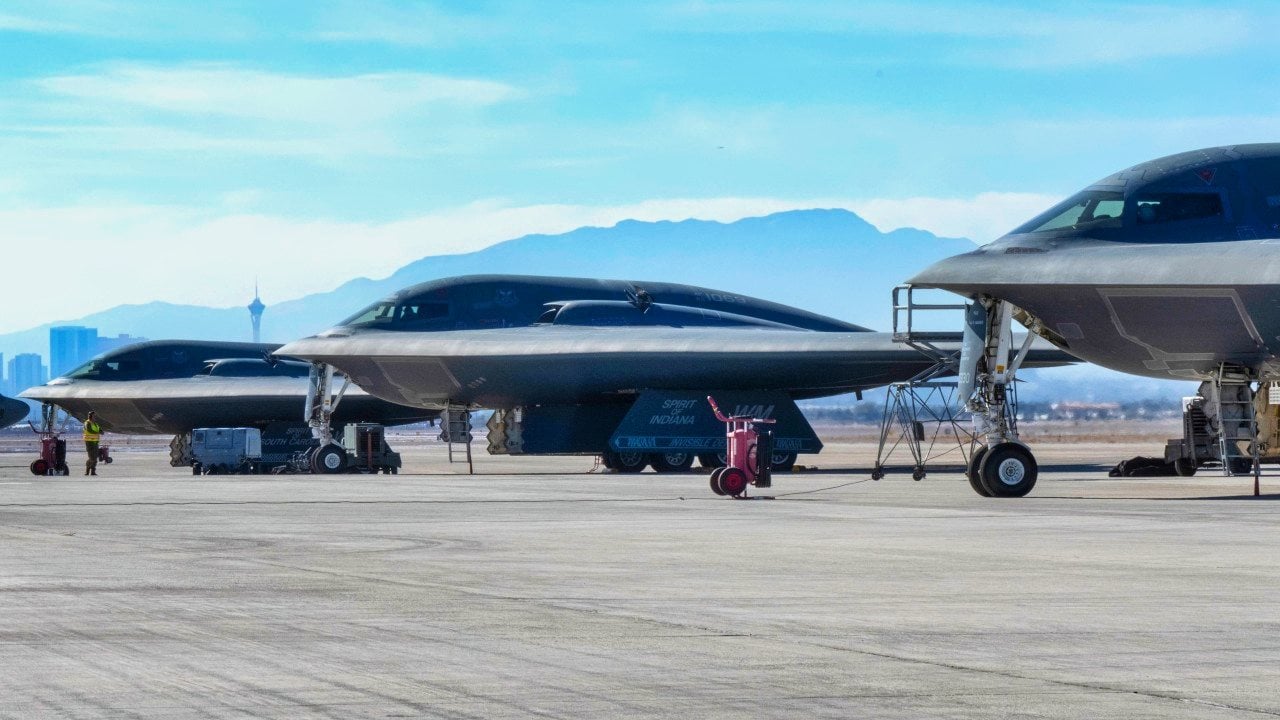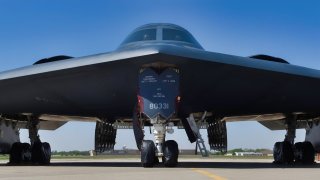This B-2 Spirit Stealth Bomber Just Set Impressive New Record
The U.S. Air Force recently completed the programmed depot maintenance (PDM) of the B-2 Spirit bomber Spirit of Nebraska ahead of schedule, returning it to service 91 days early. The PDM, crucial for restoring the aircraft's low observable (LO) stealth materials and performing extensive inspections, typically takes 470 days.
What You Need to Know: The U.S. Air Force recently completed the programmed depot maintenance (PDM) of the B-2 Spirit bomber Spirit of Nebraska ahead of schedule, returning it to service 91 days early. The PDM, crucial for restoring the aircraft's low observable (LO) stealth materials and performing extensive inspections, typically takes 470 days.

-However, improved efficiency and pre-inspections helped streamline the process. With only 19 B-2s in operation, maintaining these stealth bombers is vital for U.S. air superiority.
-Despite their upcoming replacement by the B-21 Raider, the B-2 remains the only long-range stealth bomber, capable of striking targets worldwide.
B-2 Bomber Returns to Service Early After Major Overhaul
The United States Air Force currently operates just nineteen Northrop B-2 Spirit long-range strategic bombers, meaning every single one is a truly precious commodity. The stealth aircraft aren't of much strategic value if they're sitting on the ground – yet, each one requires intense maintenance to keep the bombers flying. It is a "catch-22" that is simply unavoidable. The necessary maintenance can't be rushed, but this month, the Air Force highlighted how it can be handled with maximum efficiency.
This week, the Wright-Patterson Air Force Base (AFB), Dayton, Ohio, announced that the "Spirit of Nebraska" returned to operations more than three months ahead of schedule. The B-2 completed its programmed depot maintenance (PDM) at the base on October 15 – 91 days ahead of schedule – and will be able to resume normal operations.
"Bringing these jets into PDM, getting the work done quickly, and delivering them back to the warfighter early is a big deal," Col. Francis Marino, B-2 System Program Manager within the Bombers Directorate. "This accomplishment would not have been possible without the great partnership between our team, Air Force Global Strike Command and Northrop Grumman."
Team Spirit
Maintaining the most advanced bomber currently in service is a far more complex affair than getting the oil changed on the car. In addition to regular and ongoing maintenance, the PDM is required every nine years.
According to the Air Force, the PDM typically lasts 470 days, and includes "an exhaustive inspection, overhaul, and repair of the bomber, with much of the work focused on restoration of the bomber's Low Observable (LO) or stealth materials." A stealth bomber isn't a stealth bomber without those materials.
"PDM's main objective is to accomplish LO restoration of the aircraft," said Staci Gravette, B-2 PDM Program Manager. "Since the aircraft is stripped [for LO restoration] we are also able to do other maintenance work as well."

The Spirit of Nebraska saw that cut due to 379 days. The air service credited "several changes" made by the Air Force Life Cycle Management Center's Bombers Directorate. The maintainers worked smarter not harder, but there was also a greater focus on efficiency. That included conducting the fuel system inspection earlier in the PDM cycle. Previously, those inspections occurred later in the process – necessitating the need to duplicate work and causing delays that could last a month and a half.
The maintenance team further reduced time by conducting pre-inspections of this B-2 even before it arrived at Wright-Patterson to begin its PDM. That enabled the team to know what they were facing, prepare for issues, order parts, and devise a better schedule.
"As any aircraft continues to age, you're going to see more and more issues that need to be repaired on a PDM line," Marino added. "The pre-inspection is great because it reduces the number of surprises at PDM."
Keeping the B-2 Bomber in the Sky
The time-consuming and likely costly endeavor to keep the B-2 Spirit fleet in the sky comes even as the aircraft will begin to be retired in the 2030s as the B-21 Raider enters service. However, until the next-generation aircraft is in service, the B-2 remains a critical component of the U.S. Air Force – and that is why maintaining its "dominance is a priority for the Bombers Directorate."
It was just last week that B-2s were employed in a strike on Houthi positions in Yemen, which served as a reminder that the Spirits can strike anyone in the world without warning.
"Until the B-21 is fielded, the B-2 is the world’s only long-range penetrable strike bomber and the only aircraft that can do what we need it to do today," Marino continued. "As long as the aircraft is operational and our adversaries continue to come out with new and advanced weaponry across the electromagnetic spectrum, we're going to have to continuously invest in the B-2s lethality, its survivability, and of course its readiness. The work we're doing on the PDM line will play a key role in all of this."
Ensuring that the PDM process is as efficient as possible will help ensure the bomber can fill its role for the next decade and perhaps beyond.
"Nothing else can even come close," said Shawn Clay, B-2 Product Support Manager, referring to the capabilities of the B-2. "When you take into account that this is 1980s technology [on the aircraft] that is still leading the world today, it just speaks volumes to the amazing aircraft weapon system that it is. On top of that, the actual mission – holding our enemies at bay and giving them a moment of pause … like the thought of a B-2 coming in and before you even know it's there, the fight's all over."
Author Experience and Expertise: Peter Suciu
Peter Suciu is a Michigan-based writer. He has contributed to more than four dozen magazines, newspapers, and websites with over 3,200 published pieces over a twenty-year career in journalism. He regularly writes about military hardware, firearms history, cybersecurity, politics, and international affairs. Peter is also a Contributing Writer for Forbes and Clearance Jobs. You can follow him on Twitter: @PeterSuciu. You can email the author: [email protected].
Image Credit: Creative Commons and/or Shutterstock.


